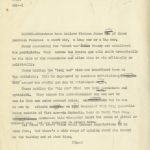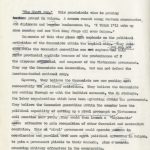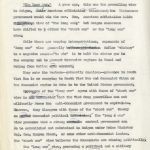1964, “Three Possible Futures”
deepe
war–1
SAIGON–Observers here believe Vietnam faces one of three possible futures: a short war, a long war or a big war.
Those expounding the “short war”teor theory are considered the pessimists. They assume the status quo will shift dramatically to the side of the Communists and will allow them to win militarily or politically.
Those holding the “long war” view are considered here as the optimists. This view is expounded by American officialdom;assum they it assumes the status quo can be maintainedas is.
Those holding the “big war” view are both pessimists and optimists. They assume the anti-Communist war can not be won in Viet Nam under present rules, so much as but it can be won by attacks outside on Viet Communist Viet Cong guerrilla bases outside of Viet Nam–in Cambodia, Laos or North Viet Nam. xmadvicites Advocates this viewpoint admit the risks of global or nuclear war, but are prepared to accept them.
All three of these views could include negotiations at in some form, but there’s a wide range of opinion about who should do the talking and at what time.
(More)
deepe
war–2
ALL three viewpoints are sharply different from the policy of official vietmm American policy line of a year agoSeptember last year, when McNamar Secretary of Defense Mc Rober Mc Robert McNamara said the military war against the Communists was progressing satisfactorily and 1000 American advisors would be withdrawn in several months. In d December, the 1,000 troopers were sent home,, but in recent weeks, Washington announced an additional 5,000 men would be sent to Viet Nam. The figures of American troo advisors jumped from 15,500 to expected 20,000 expected by the end of this year.
This is a breakdown of the three views about Vietnam‘s future:
(more)
deepe
war–3
“The Short War.” This pessimistic view is gaining in itsm ground in Saigon. A common remark among Western secretaries, and diplomats and bussine businessman is, “I think I’ll wake up some morning and see Viet Cong flags all over Saigon.”
Exponents of this view place more emphasis on the political activities of the Communists within the capital citywhole area. They saidsay that while the Communist guerrillas can not capture andbut can not hold poriv provincial capitals because of the predominance of t the airpower mechanical and manpower of the Vietnamese government. They say the Communists can demoralize, but can not defeat the American-backed national army.
However, they believe the Communists are now pushing seeu successfully thetheir political subversive activities. They believe the Communists are working through or with the Buddhist movement, the su students, the labor organizations which have been agitating withinAgainst the government. They believe the Communist guerrillas within the country have the political capability of setting up a rival government on Vietnamese soil sometime next year. Shifting from [underground state?], They would then launch a “diplomatic” offic offensive to gain recognition of other Communists and neutralist countries. This wi “rival” government would operate poliomm in coordination with and parallel withto more agiti political subversive agitation in Saigon, to gain a government pliable to their demands, plus a crunkin crunching military offensives in the countryside.
Negotiations in this case would imply virtual surrender of the American-backed anti-Communist government and army, though the time period may be expanded into a Laotian-type axxxx settlement camouflaged as a [newly unified?] Vietnam.
deepe
war–4
“The Long War.” A year ago, this was the prevailing view in Saigon, whileand American officialdom was maintaineding the Vietnamese government could win the war. Now, American officialdom holds while viem, view of “the long wark,” but Saigon observers have shifted to h either the “short war” or the “long war” view.
While there are varying interpretations, exponents of the “long war” view generally believe it amb define “victory” in a negative sense–“to win” is to hold the status quo in the country and to prevent Communist regimes in Hanoi and Peking from taking over control.
They note the Western–primarily American–presence in South Viet Nam is as annoying to North Viet Nam and Communist China as the Communist regime in Cuba is to the United States government.
Exponents of the “long war” agree with those of “short war” view in the assumptionassuming that the Viet Cong guerrillas can not militarily force the anti-Communist government to capitulate. However, they disagree with those of the “short war” theory on politi Communist political activitiespower. The “long v war” view presumes that a strong centrial central government can ve be established and maintained in Saigon under Prime Minister Maj. Gen. Nguyen Khanh, or some other anti-Communist leader. The “short war” view believes the Communists are winning politically.
The “long war” view, presuming a political and a military stalemate, would presumablythen end c with negotiations in years to come with negotiations, which would have many variations could shift in many directions, depending primarily on external forces such as American public opinion or eventualities of Sino-Soviet split.
deepe
war–5
Negotiations between presumely w presumably would mean United States and China would sit at the same conference table with other nations to and arrive at a settlement.
“The Long War.”
“The Big War.” This view rejects the pessimistic defeatism of the “short war” view, but r andalso refuses to accept the eventual unfavorable negotiated settlement of the “long war” theory, on the roun grounds that these negotiations would in the end lead to a Communist domm dominated Vietnam.
Exponents of this view want the Vietnam war internalized–internalizational and with border prosectdtmm Vietnam prosecuting the war outside its borders–against Viet Cong bases in southern Laos or “hot pursuit” of Viet Cong guerrillas across the Cambodian border. They ahso The Vietnamese government has officially advocatedhinted at both of these courses of action–plus tadvocating carrying their war into Communist Vietnam, which was the key to Prime Minister Khanh‘s “Go North” policy of last M month.
While America officially admits to the “long war” view, it appears, in reality to be wavering toward the “big war” view, whichthis is indicated in recent Tonkin Gulf incidents, bombing of North Vietnam–and ordering the Seventh Fleet into the Gulf in the first place.
The question m predominant question is, however, if the war would expand to other parts of Asia, to the rest of the world, and whether it would remain non-nuclear.
Ironically, however, the threat of a greater war in Southeast Asia also parallels the pso prospects of future negotiations.
deepe
war–6
TheBut Intensified military action souts outside of Vietnam would be used to as a leverapro-Western leverage for a better bargaining position at the future conference table.
-30-
Read Previous Article: 1964, “Nowhereville”
Read Next Article: 1964, “Perimeter Security”






